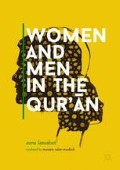Abstract
Gender Equality in Islam should not be assessed by twenty-first-century standards. While the Qur’ān remains relevant to the lives of over one-and-a-half billion people, the Qur’ānic text was revealed within a given historical context, seventh-century Arabia, with its socioeconomic and sociocultural practices and conditions. It is also important to differentiate between the Revelation and its various interpretations. The initial momentum and spirit of the Qur’ān, present in all of its prescriptions, reveals a clear empowerment of women and a disposition to establish egalitarian spirituality. This, however, is not reflected in all of the interpretations (tafāsīr). We should also note that some so-called ‘‘Islamic’’ provisions that appear unambiguously discriminatory are, in fact, the product of human interpretations of the Sacred Text.
Access this chapter
Tax calculation will be finalised at checkout
Purchases are for personal use only
Notes
- 1.
It should be noted that, whether in reference to animate or inanimate objects, singular or plural, nouns in Arabic must indicate gender (feminine or masculine), with the masculine form being the default. For example, ustādh is a male teacher, whereas ustādhah is a female teacher; likewise, mumarridh is a male nurse, whereas mumarridhah is a female nurse.
- 2.
Abraham is venerated by Islam and Muslims and is referenced numerous times in the Qur’ān. The Qur’ān relates how he preached to his community, including his father, whom the Qur’ān calls Azar, reproaching them for taking idols for gods and urging them to abandon such idols in favor of the One God (Qur’ān 6:74; 19:41–50; 21:51–73; 26:86–89; 29:16–28; 37:83–89; 43:26–28). The Qur’ān also describes Abraham as a Hanīf, the Pure or the Upright (2:35; 3:67; 4:125) and as a friend of God, Khalil-Allah (4:125).
- 3.
“It is naught but a reminder for the worlds” (Qur’ān 81:27; 12:104; 38:87; 68:52). Unless otherwise specified, the English translations of this verse and others throughout this book follow Nasr et al., The Study Qur’ān: A New Translation and Commentary (HarperOne, 2015).
- 4.
Tafsīr Ibn ‘Ashūr, At-tahrīr wa at-tanwīr. Dar Ihya’ Al Turāth, 2000. Commentary on verse 39 of sūrah 13: Umm al-kitāb is the knowledge (‘ilm) of God that only He knows. Tafsīr, also known as Qur’ānic Commentaries, is a body of commentary and clarification notes, aimed at explaining the meanings of the Qur’ān. Generally speaking, there are three categories of Tafsīr: Classical Arabic, Modern Arabic, and Tafsīr in other languages.
- 5.
The Qur’ān 5:48.
- 6.
Most Arabic words are derived from three-consonant “roots” that embody the meaning or meanings of a word. For example, the root of the words kataba (he wrote), kitāb (a book), kātib (a male author, writer, or clerk), or kātibah (a female author, writer, or clerk) is k-t-b, from which the words above and many other words that tend to be related are derived. Muslim and Islam are derived from the root s, l, m, Salama, which signifies submission, in this case to the will of the One and Only God. Thus, in a general sense, all monotheists are by definition Muslims in the sense that they are in total surrender to the One God, no matter the pathway such surrender might follow.
- 7.
The reference is to philosophers and scholars who lived during the golden age of the Judeo-Islamic culture such as Avicenna, Averroes, and Maimonides.
- 8.
Ka’ba is the holiest structure in Islam, located in the town of Mecca, Saudi Arabia. It is also the qibla, the direction that Muslims turn to when they pray.
- 9.
A hadīth reported by Abou Hurayra in Sahīh al-Bukhari, no. 273. Sahīh al-Bukhāri is a collection of hadīths compiled by Imam Muhammad al-Bukhari (d. 870), recognized by the overwhelming majority of the Muslim world to be the most authentic collection of reports of the Sunnah of the Prophet Muhammad. The collection is composed of over 7500 hadīths (with some repetition) in 97 books. The translation was done by Dr. M. Muhsin Khan.
- 10.
Ali Shariati, Fatima est Fatima, l’idéal universel feminine (Albouraq, 2009).
- 11.
Al-Suyūti, Al-jāmi’ As-saghīr, hadīth, no. 4044. Imam Jalaluddin al-Suyuti (1445–1505) was an Egyptian scholar, jurist, and prolific writer.
- 12.
‘Ali Tāntawi and Nāji Tāntawi, Akhbār ‘Umar wa akhbar ‘Abdillah ibn ‘Umar, 8th edition (Beirut, 1983), p. 145.
- 13.
Nahj al-blāgha, letter no. 31, Part 3, p. 52. Nahj al-blāgha (Peak of Eloquence) is a compilation of ‘Ali ibn Abu Tālib’s sermons, letters, and sayings, by Sayyid al-Sharif ar-Rādi, more than 1000 years ago. The Shia Muslims consider it to be the most valuable book after the Qur’ān.
Author information
Authors and Affiliations
Rights and permissions
Copyright information
© 2018 The Author(s)
About this chapter
Cite this chapter
Lamrabet, A. (2018). The Qur’ānic Revelation in Seventh-Century Arabia. In: Women and Men in the Qur’ān. Palgrave Macmillan, Cham. https://doi.org/10.1007/978-3-319-78741-1_3
Download citation
DOI: https://doi.org/10.1007/978-3-319-78741-1_3
Published:
Publisher Name: Palgrave Macmillan, Cham
Print ISBN: 978-3-319-78740-4
Online ISBN: 978-3-319-78741-1
eBook Packages: Religion and PhilosophyPhilosophy and Religion (R0)

